Follow this foolproof guide to make sauerkraut the old world way. It only requires 4 ingredients and just 20 minutes of your time.
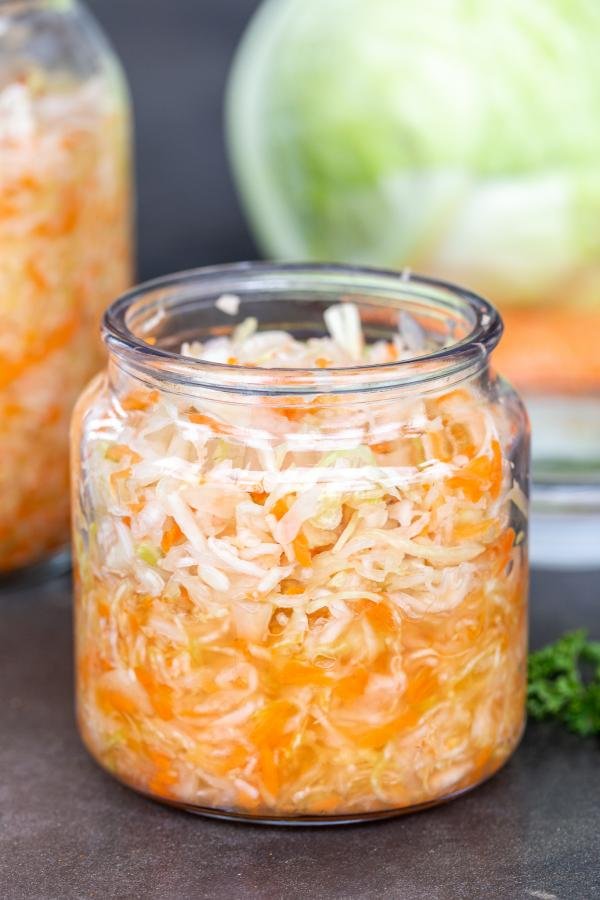
This homemade sauerkraut recipe is inspired by my Ukrainian upbringing and deep love for fermented food. This minimal ingredient, minimal prep method is the same exact one my mom and grandma would used back in our village. The only exception? We used to make a gigantic batch in a wooden barrel to have on hand for the cold winters.
Did you know? Ukrainians love to add carrots to sauerkraut for the slight sweetness. This isn’t typical for other cultures, so the choice is really up to you.

Fermenting Sauerkraut with Just Sugar & Salt
Despite the tangy flavor of sauerkraut, most recipes (especially the authentic ones) out there don’t require vinegar brine for the fermentation process. In this old world-style recipe, all you need is two pounds of cabbage, a couple of carrots, sugar and salt. That’s right – it couldn’t get any easier! But don’t worry, as the cabbage sits at room temperature, it will naturally develop that tangy flavor and taste you love and crave.
Can you use red cabbage instead? Yes, you can use this exact same recipe with red cabbage.
How to Make Sauerkraut the Old World Way
After you chop the veggies and season them, making this sauerkraut recipe is just a waiting game.
- Prep the Cabbage: First, shred the cabbage and place it into a large bowl or plastic container with a lid. Massage the cabbage with your hands until the cabbage softens a bit.
- Grate the Carrots: Next, grate the carrots and add them into the shredded cabbage.
- Season the Veggies: Add in the sugar and salt, massaging the seasoning into the veggies with your hands.
- Cover the Sauerkraut: Next, press down on the veggies with your hands. Place a large plate or lid on top and weigh it down with something heavy.
- Ferment the Sauerkraut: Place the container in a warm place for several days (day 3 is our favorite day to pull it) to ferment, checking it each day to see how it’s coming along and to inspect for mold.
- Refrigerate the Sauerkraut: Once the sauerkraut is to your liking, transfer it to a sealable jar and store it in the refrigerator for up to 2 months. Enjoy!
Hot Tip: If you’d like, add some juniper berries or caraway seeds to the sauerkraut for extra flavor.




3 Pro Tips for How to Make Sauerkraut
A couple handy tips will help you make sauerkraut that’s perfectly tangy with just the right amount of crunch and texture.
- Pick firm cabbage heads. When you’re picking up the cabbage for this recipe, opt for the firmer heads. They will yield the nicest crunch and texture after a couple of days of fermentation.
- Use a vegetable slicer to shred the cabbage and carrots. To make the prep easier and to ensure that you have consistent slices, employ the help of a veggie slicer to make slicing the cabbage and carrots a breeze.
- Cover the sauerkraut with a couple whole leaves of cabbage. Reserve a couple of whole cabbage leaves to use to cover the top of the sauerkraut. This will help create an even tighter seal and speed up the fermentation process.
Hot Tip: Leave a few whole cabbage leaves at the bottom of the container to ferment them. You can use them for cabbage rolls!

Different Ways to Serve Kraut
One of our favorite ways to use this homemade sauerkraut besides the classic kielbasa and sauerkraut is with a variety of different potato dishes. We like to serve a little alongside new potatoes with bacon and herbs or creamy herbed potatoes. Another great way to use it is to add it to cabbage soup or braised cabbage with chicken. You can also serve it tossed with just a little sunflower oil, fresh dill and thinly sliced green or yellow onions.
The Proper Way to Store Kraut
Once the sauerkraut is done fermenting at room temperature, the best way to store it is in a tightly sealed airlock Mason Jar in the fridge. When stored properly, it will last for up to 2 months this way. If you want to extend the shelf life even longer, feel free to can it and store it in your pantry.
FAQ
Is sauerkraut healthy for you?
Yes, sauerkraut is super healthy for you. It contains probiotics that support stomach health and digestion. It also contains very minimal calories to boot.
Can you ferment sauerkraut too long?
It’s best to only ferment sauerkraut using the salt and sugar method for up to a week. After that, the flavor profile doesn’t change much and it’s about as tangy as it will get.
Can you add vinegar to your sauerkraut?
There’s no need to add vinegar to sauerkraut unless you really want to. When using just sugar and salt to ferment it, you get super tangy sauerkraut without it via all the lactic acid that forms as it sits.
How do you know when sauerkraut is done fermenting?
There’s no particular sign that sauerkraut is done fermenting, as it’s up to you how tangy you want it to be. After about 3 days of fermenting at room temperature, it has a nice crunch and is quite tangy.
Does sauerkraut get more sour the longer it ferments?
Yes, sauerkraut gets more sour the longer you ferment it. It also breaks down more and becomes less crunchy the longer it sits. Typically, a 3-4 day ferment gives you the maximum tang to crunch ratio.
How do I know if my homemade sauerkraut has gone bad?
You’ll know that your sauerkraut has gone bad if any mold begins to form. This is a sign that bad bacteria has begun to form and it’s time to toss it!
More Pickled & Marinated Veggie Recipes
- Marinated Beet Salad – Beet, onion, and pepper salad
- Pickled Mini Bell Peppers – Whole mini pickled peppers
- Marinated Mushrooms – Marinated mushrooms in 15 mins of prep time
- Marinated Tomatoes – Crunchy marinated tomatoes
Recipe
Ingredients
- 2 lb cabbage shredded
- 3 large carrots grated
- 1/3 cup white sugar
- 4 tbsp fine sea salt
Instructions
- Shred the cabbage into long strips and place it in a large bowl or large plastic container with a lid. Massage the cabbage with your hands for a few minutes until the cabbage softens a bit.
- Grate the carrots on the large side of the grater. Add the grated carrots in with the shredded cabbage.
- Add in the sugar and salt to the veggies and massage the seasoning into the veggies. Press all the ingredients down with your hands and place a couple of large cabbage leaves on top.
- Place a plate large enough to cover the bowl or container on top. Place something heavy on top of the plate to weigh it down. Place the container in a warmer part of the house, where it's about 77°F.
- Check the sauerkraut on a daily basis. Day #3 is typically the best. Once it's to your liking, transfer it to a clean jar and refrigerate it for up to 2 months.


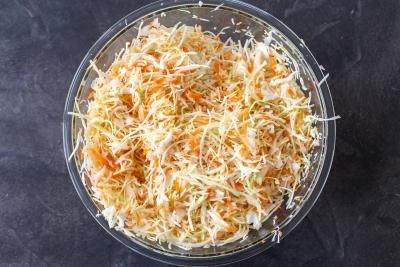
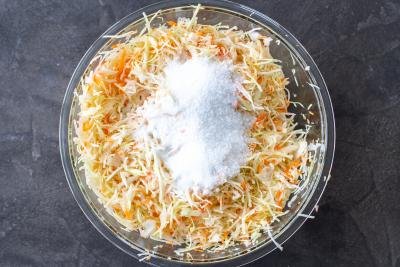
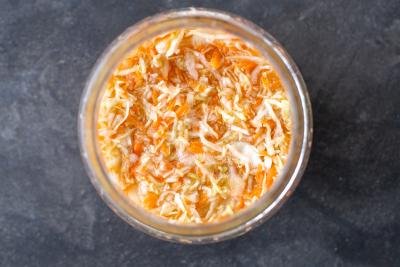
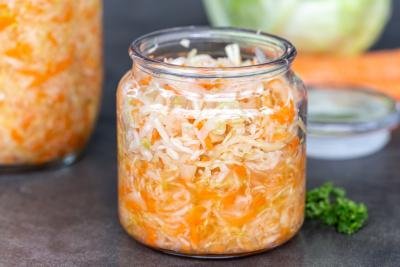
Thank you! I remember making kapusta with my mom and баба every fall. We’d go through a bushel of cabbage using a giant mandolin. I got to beat the cabbage with a макогін to get the juices flowing. Only years later was I allowed to use the mandolin. And баба always added carrots. The only thing I didn’t like was that our Chicago enclosed porch smelled like cabbage all winter! Thanks for keeping these recipes alive!
Thanks for sharing these wonderful memories Marusia. These recipes have a special place in my heart!
THANK YOU! For just giving the recipe! and not making me scroll and scroll down through the whole history of sauerkraut, the meaning and origins of cabbage and carrots, the importance of why every ingredient has to be put in there, a thousand details no common sense person would ever need, the tradition of it all and every little cutesy attention-getting, overly conversational saying that you could come up with about it.
Bless you! I just wanted a basic recipe (especially to recheck how much salt I should put in) and yours was perfect.
Hey Linda, I'm glad this recipe was just what you needed! Enjoy the sauerkraut! 🙂
Can I add Caraway seeds ?
Yes! That would add great flavor!
Can it just stay in the refrigerator in a big jar like you have there? What happens if you see mold?
Hi Selena, the best way to store it is in a tightly sealed airlock Mason Jar in the fridge. When stored properly, it will last for up to 2 months this way. I hope this helps. Thank you for your question!
hi. i always read that the cabbage should be fully submerged in juices to prevent bad bacteria during termenting time. here you don't mention that. what do you recommend? most of the time its hard to get enough juice to fully cover it.
Hey Valerie- this is correct! Earlier in the post we mention that you should cover the cabbage. After massaging the veggies, press down on the veggies with your hands. Place a large plate or lid on top and weigh it down with something heavy. Weighing it down will make sure it's submerged. Enjoy!
how much water do you add?
Hi- you don't add water. 🙂 The salt and sugar will draw the moisture out of the vegetables. Enjoy!